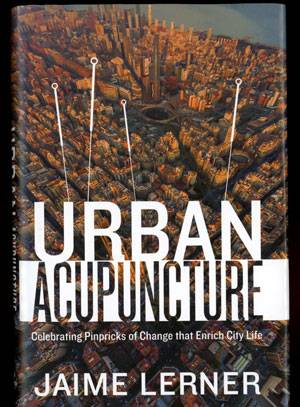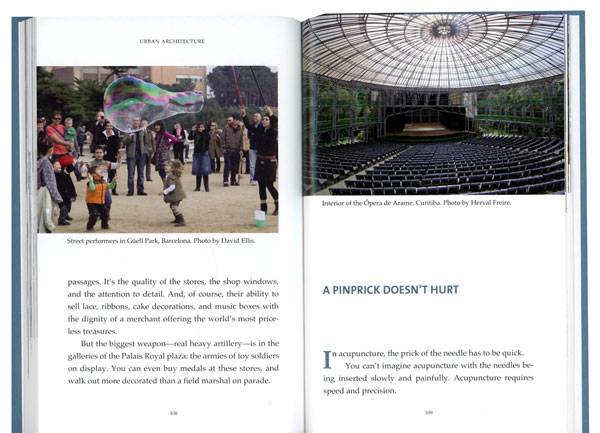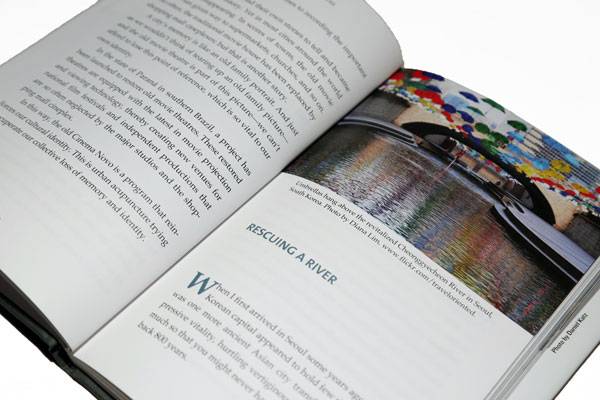A book review of Urban Acupuncture: Celebrating Pinpricks of Change that Enrich City Life by Jaime Lerner. A review of Urban Acupuncture: Celebrating Pinpricks of Change that Enrich City Life, by Jaime Lerner. Translated from the Portuguese by Ariadne Daher, Mac Margolis, and Peter Muello. Published by Island Press, 2014. Hardcover. 143 pages. Through the telling of hundreds of little urban stories, Urban Acupuncture was created to be an inspirational guide. Jaime Lerner wants us to rethink our cities and take a look closer at all of the small details and people that make up our urban landscapes.
The Structure of Urban Acupuncture

Urban Acupuncture,front cover. Photo credit: Sophie Thiel
At 143 pages, with illustrations on nearly every second page and a font size even my mother could read without difficulty, Urban Acupuncture is kept simple and of a definitely manageable size. A preface by Carol Coletta from the Knight Foundation, a foreword by Jan Gehl (who is an architect and also an author), and an introduction make up the first pages of the book. The content is then subdivided into 39 chapters, each two to six pages long. Those chapters bear names such as “People in the Streets”, “Draw your City”, or “Light is Good Acupuncture”. Every chapter tells at least one, but more often several little stories subordinated to the chapter’s specific topic. I find fault with some of the chosen chapter names. Sometimes the content of the chapters is not apparent at all, with names such as “A Letter to Fellini” or “The Presence of Genius”. Furthermore, the numbering of pages within the table of contents is missing, which makes it impossible to open the book at a specific chapter directly and solve the mystery of the chapter’s name.

Urban Acupuncture, inside book. Photo credit: Sophie Thiel
Content of Urban Acupuncture
Nevertheless, all of the chapters tell heart-warming and inspiring stories. It is these kinds of little city tales that make you wonder if a city – no matter its size – could be called a city without them. While reading the book, you can literally feel Lerner’s passion for planning and his deep understanding of every unique city he has visited in his life. Occasionally, I found it hard to continue reading the book instead of leaping up, running out to the people, and starting to change my urban surroundings for the better.

Urban Acupuncture, inside book. Photo credit: Sophie Thiel
With Urban Acupuncture, Lerner shares his visions of great cities with us. He draws our attention not only to the physical features of every city, but also to the cultural, psychological, and many other factors. As he states it: “
Just as good medicine depends on the interaction between doctor and patient, successful urban planning involves triggering healthy responses within the city, probing here and there to stimulate improvements and positive chain reactions. Intervention is all about revitalization, an indispensable way of making an organism function and change.”
Should you get Urban Acupuncture?
Professional language hardly exists, which makes this book an easy guide for anyone who wants to get involved in little changes for the better – the so-called “Pinpricks”. Of course, this is not a negative aspect, but as an evolving landscape architect, I was hoping for more detailed descriptions or sketches. However, often the most difficult tasks turn out to be much simpler than you think, and Urban Acupuncture encourages us to look for ideas and solutions that are easy to spread and to translate into practice.

Urban Acupuncture, inside book. Photo credit: Sophie Thiel
This book is definitely worth reading for anyone who is interested or involved in city life. It not only talks about planning, but also about how to be responsible for making a project spark, especially for those people working as landscape architects or city planners. Reconsidering the importance of the role residents play in every city was a something I learned throughout the book. Get inspired by this book’s straightforwardness, and start creating your own visions and pinpricks of change.
Review by Sophie Thiel Return to Homepage
Published in Blog










